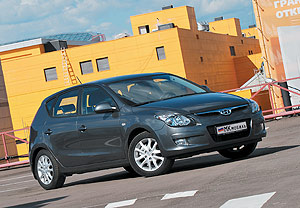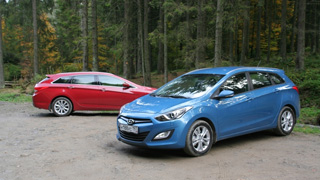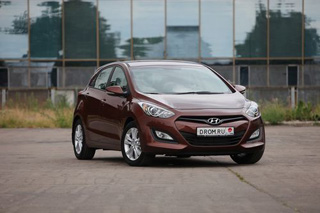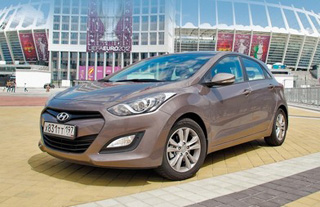Hyundai I30 test drive since 2012 Hatchback
The average geometric
 At the end of last year, Hyundai loudly announced the beginning of a massive bombardment of domestic car market
At the end of last year, Hyundai loudly announced the beginning of a massive bombardment of domestic car market Three segments, three models ...
In the best of times, this would be a serious application for leadership. But in the current situation, that the representative Genesis, that off -road IX55 can only be considered as support tools. The main load fell on the shoulders, probably the most anticipated (imported) car in the recent history of the compact hatchback i30.
His release really dragged on, because this Hyundai was demonstrated to the Russian public back in 2007 as part of the Moscow Motor show. Partly the leisurely of the Koreans explainable, they needed to sell Elantra, especially since the I30 is a nee hatchback, not burdened with unnecessary modifications (sedan and universal), and sedans were always better sold.
But that bet did not work anyway, so the novelty is quite capable of overtaking its pro -American relative. This car is at least more elegant and more dynamic. Although by and large the supernatural stylists of the European design studio did not offer: the hetchbeck muzzle somewhat reminiscent of the one-platform Kia Ced, the profile is no less Korean Chevrolet Lacetti, and the baggage compartment door is Bavarian. In general, the topic is beaten, but in general, this Euro -Asian immediacy and today looks quite original. In any case, the eye does not break.
On the other hand, a year and a half marketing downtime for the i30 was not in vain: it was old. Not critical, but noticeable, at least if you compare Hyundai with the new Mazda3 and Renault Megane. In a word, this car appeared at least a year earlier, its prospects would be more tangible. The same is worth saying about the salon. In the i30, as clean and neat as in Peugeot 308, but emotions are clearly not enough here. And with the originality of the problem, the pseudofolkswagen blue backlight and equipment today literally stuffed the word: it is beautiful only the first couple of minutes, after half an hour my eyes begin to get tired, and after an hour I want to turn off the panel.
On the other hand, the assembly quality is not lame, the quality of execution at the average European level, and as for excessive simplicity, do not forget that the correct geometry usually positively affects the eye as on ergonomics. The location of the equipment on the central console is quite logical. However, it is more important here that the set of equipment available to customers fully meets the requirements of the European market, all governing bodies easily fit on the above area. Functional buttons are reduced to a single block conveniently, but at the same time there is a mass of free space on the cockpit, which the interior, alas, does not paint. The same drawback, by the way, is also characteristic of Kia Ceed.
But the placement of passengers is at least. The steering wheel adjustable in all planes is conveniently laid in hand. The settings of the seats are not perfect, but in most cases there are enough of them that the level of comfort is at least not lower than the norms that are generally accepted in the C-class.
A worthy standard of living will provide Hyundai and the rear riders. The sofa is quite spacious, but due to the constructive features of the compact hatchback, it is still not worth counting on three full -fledged seats. But two he will accept without problems. The only restriction with the fully pushed back seats is the supply of space between their backs and the sofa pillow, as in all such cars, is minimal.
The trunk is not perfect. Not that he was bad or inconvenient (everything is in order with functionality), but otherwise there is nothing special. A relatively correct geometry, a sane volume, transformed (in a proportion of 40:60) the back of the rear seat and the corresponding increase in the loading space is not bad, of course, but the Koreans failed to surpass the competitors. On the other hand, it is nevertheless better than a foam spacer pulled out for storing a full -sized spare wheel compartment of the popular Focus.
It is a pity, but, despite the nominally wide list of power units, there are only two gasoline engines on the Russified version. Against the conclusion of turbodiesel, contrary to the latest trends, the Koreans did not dare to. We do not yet have a two -liter four, developing 143 hp, who seems to have become a victim of a crisis: too expensive. In general, domestic customers have to be content with the base 1.4-liter 109-horsepower sixteen-plane and no less fresh 1.6-liter analogue, which develops 122 hp. What is the most popular with us will be the first option. But a more powerful option will probably make him healthy competition. Unless, of course, sales of these modifications once again will not be applied to the price tag: the cost of cars with this engine starts from the mark of 640,000 rubles today, and what will happen next ...
On the go, the hatchback with a 1.6-liter unit is very good, which, frankly, was a kind of surprise. Despite the obviously lifted power indicator and the CVVT system, as a rule, straying the engine on the bottoms in such cases, this four begins to be carried almost with idle. For some time, the car, of course, is swinging, but in reality the pause lasts no more than 0.5 seconds, after which the motor begins to spin very intensively. Typically, it is not even a start from a place, but acceleration from the average revolutions: contrary to expectations, to force the hatchback to accelerate with a simple click on the pedal, to put it mildly, it will not work, it is unrealistic even at 3500 revolutions.
In a word, in such a situation, you will definitely have to switch to the lowered and twist the engine, as they say, in the ringing. By the way, the second trouble is connected with this, the lack of acoustic comfort. On the noise insulation of the salon, the Koreans, of course, worked decently: standing somewhere at a traffic light, hear the utopia motor. But it is worth touching the accelerator pedal
and to raise the power unit to the working range, its screech will not drown out even relatively good on -board acoustics.
As for behavior on the road, I30 greatly reminded the similar CEED. The pendants are harsh, but in general, the designs are quite acceptable energy intensity and stability. The body does not fall in the turns, and they do not work out artificial and natural asphalt irregularities, but tightly, which was previously uncharacteristic for the car of this brand. The sharp steering wheel also provokes active driving, however, the Koreans did not achieve absolute transparency in zero from the amplifier, which is especially noticeable when the i30 falls into the rut: the steering wheel is seemingly stable, but the car literally dangles, like a fraud Sudene in a nine -point storm.
But for the brakes, the Koreans should say special thanks. In this case, the designers clearly took the experience of German colleagues as a basis, so with a very good deceleration efficiency, the corresponding pedal turned out to be very informative. At least adaptations, as, for example, when driving French cars, it does not require.
Competitors
What is the trick?
The domestic Ford Focus is still the most popular Russian C-class car and, accordingly, the most dangerous competitor I30. However, he does not have so many truly strengths. Firstly, the car offers exactly the same amount of comfort and is done approximately at the same level. And secondly, Ford is not as cheap as it seems at first glance.
The basic version is estimated today at 345,000 rubles, but the next step in the price list starts from a mark of 521 200 rubles. So the only serious advantage of Focus can only be considered a greater selection of power units.
Rezvushka
The second generation of Mazda3 may well claim the title of the main news of the season. The new nesting doll is decorated in the same vein as the predecessor, but she has a more modern and high -tech interior and a lot of new equipment. Engines, as before, two 1.6 and 2 liters, but unlike Europe, cars with motors sharpened not under Euro-5, but under Euro-4, will be supplied to us, so we will be more dynamic. The first cars will come to the dealers in about a month. The prices for the model, however, are still unknown, but they are unlikely to exceed the bar established by competitors.
With the Russian soul
With the Russian release of the sixth generation of Golf, the Germans clearly dragged on, but at the same time managed to register it on the Kaluga conveyor, so the prices of the new product will not become sky -high. It is already known today that the cheapest Golf will cost 592,000 rubles. Under the hood of such a machine, a proven 102-horsepower 1.6-liter engine, aggregated with the manual transmission, will be installed. In total, for the novelty, the Germans proposed three engines: in addition to the already mentioned 1.4 FSI, as well as a 2-liter 210-horsepower four, installed on the GTI version.
Vladimir Zhidkov
Photo author: Armen Meitarjan
Source: MKOMBILA magazine [July/2009]

.jpg)
.jpg)
.jpg)
.jpg)
.jpg)






